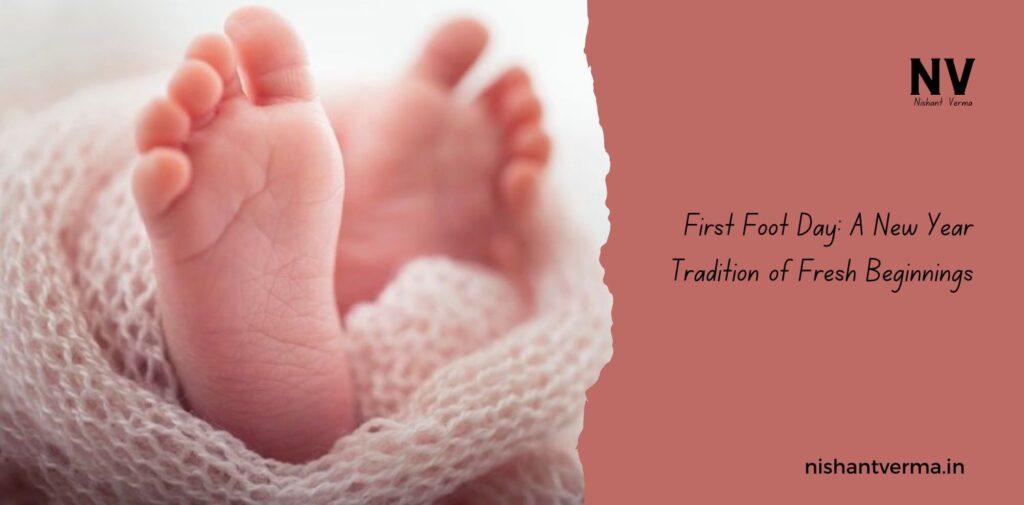The start of a new year is celebrated all over the world with joy, excitement, and a sense of renewal. One tradition that marks the beginning of the year is First Foot Day, observed on January 1st. This day is rooted in ancient customs and symbolizes a fresh start, new opportunities, and the hope of good fortune for the year ahead. For many people, the first person to step into a house on New Year’s Day is believed to bring either good or bad luck. In India, where customs and rituals have a deep cultural significance, First Foot Day carries unique meaning and is often intertwined with various local traditions and celebrations.
What is First Foot Day?
First Foot Day, celebrated on January 1st, is a tradition observed in many parts of the world, particularly in countries like Scotland and Ireland, where it is closely linked to the belief in the “first-footer” — the first person to enter a home after midnight on New Year’s Eve. This first person is often considered to bring either good luck or bad fortune for the upcoming year, depending on certain customs.
The first-footer is typically a person with certain characteristics, such as being tall, dark-haired, and having a strong, healthy appearance. These traits are believed to symbolize strength and prosperity. The tradition of First Foot Day is linked to the hope of welcoming a year of good fortune, health, and success. In India, while this specific tradition might not be as widely known, the idea of welcoming the new year with positive energy and optimism is very much a part of our culture.

Why is First Foot Day Important?
- Symbol of New Beginnings: First Foot Day is a way of symbolizing the start of a new year. In many cultures, stepping into the new year with positive intentions is seen as an important ritual. The first footstep is thought to set the tone for the rest of the year, signaling fresh beginnings, new opportunities, and a hopeful outlook. In India, the new year is a time for starting fresh, whether it’s through resolutions, new plans, or spiritual renewal. This aligns with the spirit of First Foot Day, which encourages individuals to embrace the new year with optimism and enthusiasm.
- Bringing Good Luck: In the traditional customs of First Foot Day, the first person to enter a house on January 1st is believed to bring either good luck or misfortune. The idea behind this belief is that the person’s energy and qualities will influence the fortune of the household for the year to come. In some cultures, the first-footer is expected to bring gifts, such as coal or bread, symbolizing warmth and sustenance for the year. In India, luck and fortune are important elements in many cultural celebrations. For instance, festivals like Diwali are centered around the idea of welcoming good luck and prosperity into homes. Similarly, the concept of bringing good luck on First Foot Day reflects the Indian emphasis on positivity and fortune in the new year.
- Cultural Traditions and Family Bonds: First Foot Day also strengthens the sense of community and family. The practice of gathering together and waiting for the first-footer reflects the value placed on unity and togetherness. It serves as a reminder that no matter the year or challenges, the support of family and friends is essential for success and happiness. In India, family is at the heart of many customs, and the new year is a time to reconnect with loved ones. Whether through shared meals, prayers, or family gatherings, First Foot Day reminds us of the importance of these bonds in helping us navigate the year ahead.

How is First Foot Day Celebrated in India?
While the specific tradition of First Foot Day may not be widely practiced in India, the ideas behind it can be seen in various New Year celebrations and regional customs. India’s rich diversity of cultures, languages, and traditions means that the new year is celebrated in different ways across the country, but many of the key elements—such as welcoming good fortune, family togetherness, and fresh starts—are common themes.
Here’s how First Foot Day can be reflected in Indian culture:
- Welcoming the New Year with Positive Rituals: The concept of stepping into the new year with good energy can be found in many Indian traditions. On New Year’s Day, many people start the day with a visit to a temple, a family prayer, or a ritual to seek blessings for the year ahead. For instance, in states like Tamil Nadu and Andhra Pradesh, people celebrate Pongal or Ugadi, marking the harvest and the beginning of a new year. On this day, people often perform religious ceremonies, decorate their homes with rangolis (colorful patterns made on the floor), and engage in feasts with family and friends.
- Similarly, the first step into the new year, often accompanied by prayers or rituals, represents the symbolic “first foot” of a fresh beginning and spiritual renewal.
- Festive Food and Gifts: In many parts of India, New Year celebrations are marked by preparing special foods and exchanging gifts. In the context of First Foot Day, gifts may be exchanged on the first day of the year to symbolize goodwill and blessings. People often prepare sweet and savory dishes, which are shared among family members and neighbors.
- Some specific foods carry symbolic meaning in Indian traditions. For example, during Pongal, the preparation of the sweet dish known as “Pongal” is an important ritual that signifies prosperity and abundance for the year ahead. Similarly, fruits like sugarcane and new vegetables are often shared during New Year celebrations in India, symbolizing a fruitful year ahead.
- Traditional Greeting and Blessings: On First Foot Day, the greeting “Happy New Year” is common across India, but it is also a time when specific blessings are exchanged, particularly among family members. Elders bless the younger generation for success and happiness, and the younger ones show respect to elders by seeking their blessings. These acts of goodwill and respect symbolize a shared commitment to positive relationships in the coming year.
- Regional Celebrations and Customs: In some regions, like Punjab and Haryana, the new year is celebrated during the festival of Baisakhi, a harvest festival. On this day, people often visit relatives and friends, offering each other prayers and well-wishes for prosperity. Although the celebration doesn’t always involve the “first-footer” tradition, the theme of welcoming good fortune is still prominent.
- In Maharashtra, the beginning of the new year is marked by Gudi Padwa, where families erect a Gudi (a decorated flagpole) in front of their homes, symbolizing victory and prosperity. The idea of welcoming the new year with open arms and positive energy is central to these celebrations.
- First Step for Success: In many Indian families, taking the first step of the year toward something meaningful is considered important. For instance, starting a new business, enrolling in a course, or taking part in a spiritual practice might be seen as auspicious. This act of starting something new on the first day symbolizes the commitment to success and growth.
Conclusion
While the concept of First Foot Day, with its roots in ancient traditions, may not be widely practiced across India, its message resonates with the spirit of the country’s diverse New Year celebrations. The idea of welcoming the new year with positive energy, good fortune, and a commitment to fresh beginnings aligns well with Indian values of renewal, family, and prosperity.
Whether it’s through prayers, festive foods, family rituals, or simply the act of taking a meaningful step on the first day of the year, First Foot Day serves as a reminder to enter the year with hope and optimism. As we celebrate this tradition, let us step into the new year with positivity and the promise of growth, prosperity, and happiness for ourselves and our loved ones.




